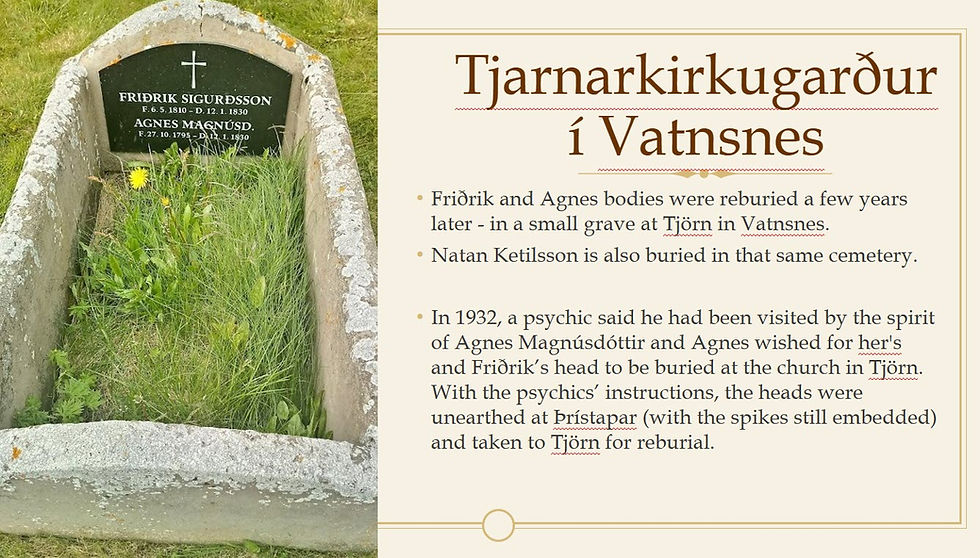Agnes Magnúsdóttir 27 October 1795 – 12 January 1830 October’s interesting Icelander is a gruesome tale of love, greed, jealousy, ghosts, murder, and executions; one that is befitting with Hallowe’en just around the corner!
Agnes Magnúsdóttir, IR#I200595, had a short yet significant life. Her story isn’t grand. She didn’t live a long life. She had no significant accomplishments unlike some of the individuals we have profiled in our monthly Interesting Icelander series. Her notoriety: Agnes was the last person in Iceland to have been executed by beheading. The execution took place on 12 January 1830.
Born in Northern Iceland to unwed parents and into extreme hardship as her birth was just eleven years after the Laki volcanic eruption; she had a meager upbringing. The years following the Laki volcano, called The Mist Years, presented challenging and horrific living conditions in Iceland and around the world. Agnes’ father left when she was very young and her mother, being unwed and a laborer, couldn’t work and look after Agnes and her older brother. The children soon found themselves fostered to other families who would provide food and shelter while the children toiled.

Agnes’ story cannot be told without linking to a few other individuals whose collective story has been captured in verse, song, books, and film over the years. Still, nearly two hundred years later, her story remains of keen interest. Much of the more recent interest is attributed to the book written by Hannah Kent called Burial Rites. This title may sound familiar to you as it was this October's Icelandic Roots Members’ Book Club selection. It’s an excellent book and I highly recommend reading it.

Agnes remained a farm laborer all her life. She believed her life took a positive turn when she met Natan Ketilsson, who was smitten with Agnes. He found her mind sharp, encouraged her intellect, and brought her to work at his farm, Illugastaðir. His encouragement of her learning and his display of affection caused Agnes to believe they might wed.

Natan was often travelling long distances for extended periods as he was an herbalist and considered a healer. Natan, however, was known to be unscrupulous in business, a womanizer, and seemingly disturbed. People either loved or hated him.

Agnes believed in her place with Natan until they arrived at Illugastaðir, where Agnes met Sigriður, a girl of sixteen. Agnes thought Sigriður would work for her until Natan declared Agnes worked for Sigriður. Natan also took Sigriður to his bed, shunning Agnes. All the while, Sigriður was the sweetheart of Fridrik, a local farm hand who also worked part-time at Illugastaðir. Fridrik was jealous of Natan and Sigriður and of Natan’s perceived wealth, always watching Natan then scheming to find the hidden goods.
As the situation escalated, the three farmhands, now allies, schemed to rid Natan of some of his wealth and sort out the relationships. One night in March 1828 while Natan and a guest slept in the house, they were murdered and burned when the house was set on fire.
After court proceedings, Agnes was found guilty as charged with two counts of murder. Her penalty was capital punishment; execution by beheading. Fridrik was also found guilty and received the same sentence. For her part, Sigriður was sentenced to life in prison and sent to Denmark to serve her time.

On 12 January 1830, in Vatnsdalur, Fridrik was executed, followed by Agnes. She was the last person in Iceland to be executed.
Today, the site near where the execution took place is found a short distance from the Ring Road on route to Blönduós. There the three hills are visible; the middle one is where the executions took place.
One can see the replica of the platform and the axe. The original axe, which was imported from Denmark, and the execution platform are at the Iceland National Museum in Reykjavik.

In September of this year, the Icelandic Roots volunteer’s 10th Anniversary tour stopped by Vatnsdalur ('Lake Valley') in Austur-Húnavatnssýsla. They walked along the designated path outside of the protected area called Þrístapar, meaning three hills. This path was aligned with plaques describing the execution and those involved on that gloomy January day in 1830.

Spectators in 1830 were prevented from getting too close by a fence. Similarly, the volunteers viewed from behind the perimeter fence the rough terrain that remains much as it was two hundred years ago. Visible were the replicas of the execution platform and the axe, but also two tall spikes where the heads of Agnes and Fridrik were displayed. Story has it that within the first twenty-four hours, the heads were removed. For almost a hundred years, no one knew what happened to them.
A very interesting article on the Mental Floss website talks about the finding of the two heads around 1930, a hundred years after the execution and their disappearance:
“…a local woman who claimed to have been visited by Agnes’s spirit came forward with their location. The identity of the thieves remains a mystery, although legend has it that a kind-hearted housewife felt moved to bury them herself. Bizarrely, the heads were found just where the informant said they would be, “‘in the direction of the setting sun at high summer’ and not far from the execution mound,” according to crime writer Quentin Bates.”
This site’s article also comments on a more recent reassessment of Agnes' trial. Their finding was she would have been convicted, but serve up to fourteen years in prison, not a death sentence. I found this an interesting follow-up to Agnes’ story. What do you think?

For more reading, I suggest reviewing the Icelandic Roots database (for all-access members only), but also:
Mental Floss: The Mysterious Murder Case That's Captivated Iceland for Nearly 200 Years https://www.mentalfloss.com/article/524143/mysterious-murder-case-thats-captivated-iceland-nearly-200-years
Wikipedia https://en.wikipedia.org/wiki/Agnes_Magn%C3%BAsd%C3%B3ttir
Total Iceland: The Place Where the Last Execution in Iceland https://totaliceland.com/place-last-execution-iceland/
Do you have an Interesting Icelander in your ancestry that you would like to share? Please send us your story at outreach@icelandicroots.com.
